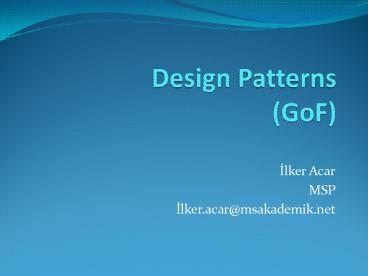Design Patterns GoF PowerPoint PPT Presentation
1 / 39
Title: Design Patterns GoF
1
Design Patterns(GoF)
- Ilker Acar
- MSP
- Ilker.acar_at_msakademik.net
2
Agenda
- Overview
- Why Pattern?
- Design Patterns
- Creational Patterns
- Structural Patterns
- Behavioral Patterns
- References
3
Overview
- Pattern Best solution for a problem
- 23 GoF Patterns, Gangs Of Fours
- Creational Patterns (5)
- Singleton,Abstract Factory, Factory Method,
Builder, Prototype - Structural Patterns (7)
- Adapter,Bridge,Composite,Decorator,Facade,Flyweig
ht,Proxy - Behavioral Patterns (11)
- CoR,Command,Interpreter, Iterator,
Mediator,Memento,Observer, State,Strategy,
Template Method, Visitor
4
Why Pattern?
- Easy to Manage
- Best Practices
- Modification
- Extensibility
- Reusability
5
Creational Patterns
6
CP- 01 Singleton
7
CP- 01 Singleton(contd.)
- Intent
- Ensure a class only has one instance, and provide
a global point of access to it. - Examples
- Printer spooler, Window manager, File System,
LoadBalancer
8
CP-O2 Abstract Factory (contd.)
- Intent
- Provide an interface for creating families of
related or dependent objects without specifying
their concrete classes. - Examples
- Database Infrastructure, Windows/Web Forms
9
CP-O2 Abstract Factory (contd.)
10
CP- 03 Factory
- Intent
- Define an interface for creating an object, but
let subclasses decide which class to instantiate.
Factory Method lets a class defer instantiation
to subclasses.
11
CP-04 Builder
- Intent
- Separates object construction from its
representation
12
CP-05 Prototype
- Intent
- A fully initialized instance to be copied or
cloned
13
Structural Patterns
14
SP-01 Adapter
- Intent
- Convert the interface of a class into another
interface clients expect. Adapter lets classes
work together that couldn't otherwise because of
incompatible interfaces.
15
SP-02 Bridge
- Intent
- Separates an objects interface from its
implementation
16
SP-03 Composite
- Intent
- A tree structure of simple and composite objects
17
SP-04 Decorator
- Intent
- Add responsibilities to objects dynamically
18
SP-05 Facade
- Intent
- A single class that represents an entire
subsystem
19
SP-06 Flyweight
- Intent
- Use sharing to support large numbers of
fine-grained objects efficiently.
20
SP-07 Proxy
- Intent
- An object representing another object
21
Behavioral Patterns
22
BP-01 Chain of Responsibility
- Intent
- A way of passing a request between a chain of
objects
23
BP-02 Command
- Intent
- Encapsulate a command request as an object
- Examples
- Undo/ Redo Operations
24
BP-03 Interpreter
- Intent
- Given a language, define a representation for its
grammar along with an interpreter that uses the
representation to interpret sentences in the
language.
25
BP-04 Iterator
- Intent
- Sequentially access the elements of a collection
26
BP-05 Mediator
- Intent
- Defines simplified communication between classes
27
BP-06 Memento
- Intent
- Capture and restore an object's internal state
28
BP-07 Observer
- Intent
- A way of notifying change to a number of classes
29
BP-08 State
- Intent
- Alter an object's behavior when its state
changes
30
BP-09 Strategy
- Intent
- Encapsulates an algorithm inside a class
31
BP-10 Template Method
- Intent
- Defer the exact steps of an algorithm to a
subclass
32
BP-11 Visitor
- Intent
- Defines a new operation to a class without change
33
BP-11 Visitor (contd.)
34
Summary
- Creational Patterns
- Abstract Factory Creates an instance of several
families of classes - Builder Separates object construction from
its representation - Factory Method Creates an instance of several
derived classes - Prototype A fully initialized instance to
be copied or cloned - Singleton A class of which only a single
instance can exist
35
Summary (contd.)
- Structural Patterns
- Adapter Match interfaces of different
classes - Bridge Separates an objects interface
from its implementation - Composite A tree structure of simple and
composite objects - Decorator Add responsibilities to objects
dynamically - Facade A single class that represents an
entire subsystem - Flyweight A fine-grained instance used for
efficient sharing - Proxy An object representing another
object
36
Summary (contd.)
- Behavioral Patterns
- Chain of Resp. A way of passing a request
between a chain of objects - Command Encapsulate a command request as
an object - Interpreter A way to include language
elements in a program - Iterator Sequentially access the
elements of a collection - Mediator Defines simplified
communication between classes - Memento Capture and restore an object's
internal state - Observer A way of notifying change to
a number of classes - State Alter an object's
behavior when its state changes - Strategy Encapsulates an algorithm
inside a class - Template M. Defer the exact steps of an
algorithm to a subclass - Visitor Defines a new operation to
a class without change
37
References / Useful Sources
38
Questions
- ?
39
Thank You !
- Ilker Acar
- Microsoft Student Partner (MSP)
- Contact
- Mail ilker.acar_at_msakademik.net
- Web http//www.ilkeracar.com
- Blog http//iacar.spaces.live.com

